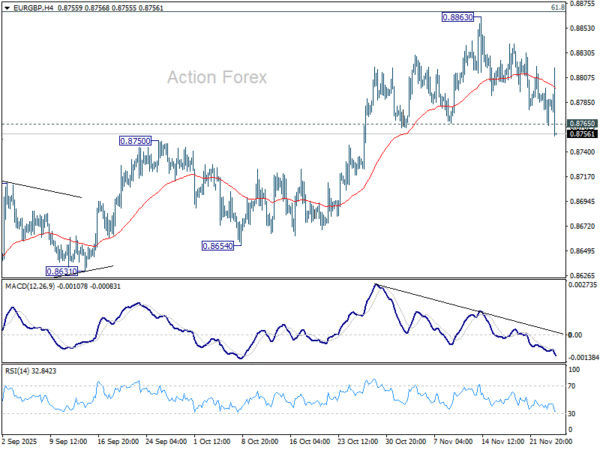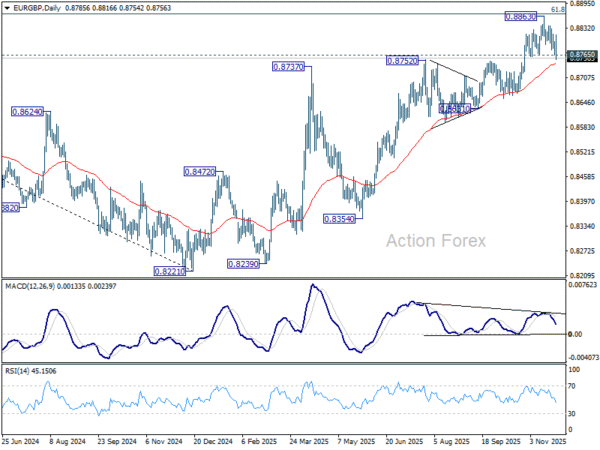Sterling Rises as UK Autumn Budget Clears Key Stability Test – Action Forex

Sterling advanced broadly today as markets reacted positively to the highly anticipated Autumn Budget. Early jitters surfaced when the OBR mistakenly published its fiscal forecasts ahead of schedule, triggering brief volatility in both the Pound and 10-year gilt yields. But once the dust settled, sentiment stabilized and then improved further as the full details were unveiled.
Chancellor Rachel Reeves confirmed that the UK is on course to meet her “stability rule” — achieving a balanced current budget with significantly larger headroom than before. The buffer for FY2029-30 now stands at GBP 21.7B, offering a stronger cushion against fiscal shocks. Markets welcomed the commitment to discipline, helping underpin the rebound in gilt prices and GBP.
However, the near-term deficit profile was less flattering. The OBR projected larger shortfalls from FY2025 through FY2028 than those seen in the spring statement. Even so, the medium-term framework and the stronger end-of-decade headroom were treated as credible enough to retain investor confidence.
Growth projections painted a mixed picture. The OBR now expects UK GDP to expand 1.5% in 2025, an upgrade from March’s 1% outlook. But forecasts for 2026 and 2027 were revised down to 1.4% (from 1.9%) and 1.5% (from 1.8%) respectively, highlighting the structural constraints still weighing on the economy.
Elsewhere in the currency markets, Dollar found some support from a lower-than-expected jobless claims print. Although the data does little to alter the prevailing view that the Fed is leaning toward a risk-management cut in December, it strengthens the case that a long pause is likely to follow as policymakers assess how the economy digests monetary loosening and tariff-related impacts.
But in today’s performance scoreboard, Kiwi remains the clear outperformer. RBNZ’s hawkish rate cut signaled that the easing cycle may already have ended, prompting further unwinding of previously priced-in dovishness. Aussie followed closely behind as stronger-than-expected CPI data pushed expectations for the next RBA cut further into 2026. Sterling sits in third place
Yen is the weakest performer amid renewed selling in early US trading, followed Euro. Dollar is the third worst, though it has potential to recover into the session. Swiss Franc and Loonie are holding the middle ground.
In Europe, at the time of writing, FTSE is up 0.56%. DAX is up 0.44%. CAC is up 0.47%. UK 10-year yield is down -0.021 at 4.478. Germany 1-year yield is up 0.012 at 2.692. Earlier in Asia, Nikkei rose 1.85%. Hong Kong HSI rose 0.13%. China Shanghai SSE fell -0.15%. Singapore Strait Times rose 0.36%. Japan 10-year JGB yield rose 0.015 to 1.819.
US durable goods rise 0.5% mom in September, ex-transport strength stands out
US durable goods orders rose 0.5% mom to USD 313.7B in September, matching expectations. The headline increase was driven primarily by transportation equipment, which climbed 0.4% mom to USD 110.7B, extending gains for a second month.
Ex-defense orders also inched 0.1% higher to USD 290.6B, reflecting still-modest momentum across broader manufacturing categories.
The stronger signal came from core orders, with ex-transportation rising 0.6% mom — well above the 0.2% consensus — to USD 202.9B. The data suggest business investment remains resilient, offering a mild counterweight to recent signs of cooling elsewhere in the economy.
US initial jobless claims fall to 216k vs exp 226k
US initial jobless claims fell -6k to 216k in the week ending November 22, below expectation of 226k. Four-week moving average of initial claims fell -1k to 224k.
Continuing claims rose 7k to 1960k in the week ending November 15. Four-week moving average of continuing claims rose 750 to 1956k.
RBNZ delivers 25bps cut but signals little room for further easing
RBNZ cut the OCR by 25bps to 2.25% as widely expected, but the tone of the announcement was more hawkish than markets had anticipated.
Policymakers revealed they had debated holding rates at 2.50% versus cutting to 2.25%, and the final decision was reached by a 5–1 vote. The lone dissenter in favour of holding highlights pockets of concern about easing too deeply and reflects a more cautious internal balance than many had assumed.
More importantly for markets, RBNZ’s updated forward guidance showed a notably firmer policy path. The Bank now expects the OCR to bottom at just 2.2% through 2026 before gradually rising to 2.7% by the end of 2027. That trajectory implies minimal scope for further cuts next year if the economic outlook holds, effectively signaling that today’s move may mark the end of the easing cycle.
The accompanying statement reinforced that message. RBNZ said economic activity was weak through mid-2025 but is now improving, with lower interest rates supporting household spending and the labor market stabilizing. The fall in the exchange rate is also lifting exporters’ incomes, reducing the need for more aggressive stimulus from here. Risks to the inflation outlook are now viewed as “balanced”.
Australia CPI surges to 3.8% in October, goods and services prices accelerate
Australia’s CPI accelerated more than expected in October, rising from 3.5% yoy to 3.8%, beating expectations of 3.6%. Underlying pressure also firmed, with trimmed mean CPI moving up from 3.2% to 3.3%.
Both goods and services inflation picked up, with annual goods inflation at 3.8% (up from 3.7%) and services inflation at 3.9% (up from 3.5), signaling renewed price momentum. The combination will keep the RBA wary of easing again too soon.
The details showed broad-based increases. Housing costs was the largest contributor at 5.9%, followed by food and non-alcoholic beverages at 3.2%, and recreation and culture at 3.2%.
The release is also notable as the first in which Monthly CPI replaces the quarterly gauge as Australia’s primary headline measure.
EUR/GBP Mid-Day Outlook
Daily Pivots: (S1) 0.8770; (P) 0.8784; (R1) 0.8803; More…
EUR/GBP’s fall from 0.8663 extends lower today. The break of 0.8765 support confirms short term topping at 0.8863, on bearish divergence condition in 4H MACD. Intraday bias is back on the downside for 55 D EMA (now at 0.8742) first. Sustained break there will be an early sign of bearish trend reversal. For now, risk will stay on the downside as long as 0.8862 resistance holds, in case of recovery.
In the bigger picture, rise from 0.8221 medium term bottom is still seen as a corrective move. Upside should be limited by 61.8% retracement of 0.9267 to 0.8221 at 0.8867. Sustained trading below 55 W EMA (now at 0.8588) should confirm that this corrective bounce has completed. However, decisive break of 0.8867 will suggest that EUR/GBP is already reversing whole decline from 0.9267 (2022 high). That should pave the way back to 0.9267.

